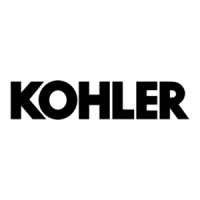
Do you have a question about the Kohler KS590 and is the answer not in the manual?
General safety guidelines and warnings for operating and servicing the engine.
Instructions for performing maintenance tasks on the engine.
Schedule of recommended maintenance intervals for engine service.
Information on identifying engine model, specification, and serial numbers.
Key technical specifications for the engine, including bore, stroke, and displacement.
Detailed torque values for various fasteners and components.
Specific clearance measurements for engine parts like camshaft, connecting rod, and crankshaft.
List of specialized tools required for engine service and their sources.
General guide to identify and resolve common engine starting and running problems.
Procedure to test crankcase vacuum using a manometer or gauge.
Procedure for testing cylinder sealing using external air pressure.
Description and operation of the optional pulse fuel pump.
Procedures for testing the fuel system to diagnose starting and running issues.
Overview of the typical one-barrel carburetor and its components.
Checklist for common issues before adjusting or disassembling the carburetor.
Table of common carburetor issues, possible causes, and conclusions.
Description and testing procedure for the fuel shut-off solenoid.
Explanation of the float, slow/mid-range, and main circuits of the carburetor.
Guidelines for adjusting low idle speed and high speed RPM.
Detailed steps for cleaning, inspecting, and servicing carburetor components.
Explanation of the Smart-Choke system's operation and components.
Troubleshooting common issues related to the Smart-Choke system.
Step-by-step procedures for diagnosing Smart-Choke system faults.
Procedure for adjusting the engine's maximum no-load speed.
Procedure for setting the engine's low idle speed.
Procedure to adjust high speed RPM on engines with separate controls.
Explanation of the governor's function in maintaining engine speed.
Notes and procedures for adjusting the governor setting.
Procedure for checking the engine oil level.
Steps for changing the engine oil and oil filter.
Procedures for testing 3-terminal and single-terminal oil pressure switches.
Procedure for testing engine oil pressure using an oil pressure tester.
Guidelines for avoiding damage to the electrical system and components.
Schematic showing the electrical connections for the battery charging system.
Electrical diagram illustrating the charging system with Smart-Choke integration.
Electrical schematic showing the charging system with fuel relay functionality.
Electrical diagram for charging system with fuel and stator brake relays.
Testing procedures for the 12/15 amp battery charging systems.
Step-by-step guide to test the engine's charging system.
Information on the spark plug, its specifications, and service procedures.
Procedure for removing, cleaning, and installing the spark plug.
Procedures for testing ignition systems using a specialized tester.
Steps to isolate and verify ignition system problems.
Procedure to test for spark production using an ignition tester.
Procedure to test the ignition module's resistance using an ohmmeter.
Explanation of the fuel shut-off relay circuit and its function.
Procedures for troubleshooting the fuel shut-off relay and circuit.
Table of conditions, key switch states, and expected voltages for troubleshooting.
Description of the blade stop stator brake and fuel shut-off circuits.
Procedures for troubleshooting the stator brake system.
Troubleshooting steps when engine cranks but won't start due to brake relay interaction.
Guide to diagnose and resolve engine starting problems.
Information on inertia drive starters, their operation, and serviceability.
Procedures for testing inertia drive starters under various conditions.
Procedure to remove the cylinder head and its components.
Explanation of the ACR mechanism, its operation, and benefits.
Inspection of pistons and rings for scuffing, scoring, and detonation damage.
Procedure for installing new piston rings, including orientation and gap checks.
Inspection of crankshaft gear, journals, keyways, and crankpin.
Procedure for accurately measuring piston-to-bore clearance.
Procedure to install the cylinder head, including gasket and torque sequence.
Final checks before starting the engine after reassembly.
Recommendations for testing the engine after reassembly.
